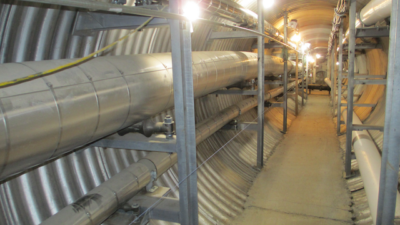Over the years as UPS and generator equipment manufacturers have worked together to solve the problems that arise from operating uninterruptible power supply (UPS) equipment with gensets. Solutions to common problems have been uncovered and designers are increasingly aware of these issues:
%%POINT%% Since UPS equipment is a non-linear load to a generator set, the harmonic currents drawn by the UPS were recognized to cause incremental alternator heating. Designers, recognizing this, can specify oversized alternators to serve this type of load. Dramatic generator set over-sizing (2 to 3 times UPS rated kVA) has been found to be unnecessary. Alternator suppliers have varying recommendations, but alternator sizing for UPS will result in an alternator of more than 15-20% larger than is required for a linear load of similar magnitude. Designers also recognize that alternators can be oversized without over-sizing engines (within limits), eliminating light load operation problems with engines.
%%POINT%% The harmonic currents also causes voltage waveform distortion that is typically more pronounced while operating on generator sets than while operating on the utility service. The voltage waveform distortion is greater on the generator set than on the utility because the impedance of the generator is higher. To make the generator equal in impedance to the utility, it would need to be much larger than is practical to provide. Consequently, the system designer is often forced to judge the level of harmonic distortion that is acceptable-often with little solid guidance. Specifying a maximum allowable subtransient reactance on the alternator will result in the best practical performance that can be achieved and proposals from various manufacturers can be properly evaluated.
%%POINT%% Voltage waveform distortion can disrupt the operation of generator set voltage regulators. Use of 3-phase sensing digital voltage regulators, separate excitation power systems such as permanent magnet generators (PMG), and pulse width modulation in the AVR can eliminate these problems, making generator set almost immune to AVR misoperation due to distortion.
%%POINT%% Voltage distortion problems with AVR equipment sometimes made generator governors appear to be unstable, causing rectifier misfiring in the UPS equipment. Again, these issues are relatively uncommon now when digital excitation controls are used. Some manufacturers offer digital governing systems that make engines more stable by sensing engine temperature and readjusting governing gains as a function of engine temperature.
ü Designers recognize that generator set frequency will never be as constant as the utility, and load changes will cause transient voltage and frequency conditions that can be disruptive to UPS equipment. Settings of UPS equipment for slew rates that are achievable with generator equipment (3-5 Hz/sec) can minimize alarm conditions.
%%POINT%% Occasionally UPS equipment was disrupted by transfer switch operation. Operating the transfer switch too quickly between energized sources caused rectifier failures or misoperation. Simple and commonly available “programmed transition” (short time delays in “open” position) or fast closed transition transfer solved these issues.
New problems emerge
This awareness doesn’t mean that the UPS/generator compatibility issue can now be ignored. As always, finding and fixing 90 percent of the problems won’t earn anyone accolades. Facility designers are expected to produce systems that are 100 percent operational and reliable under all conditions. So, in addition to specifying equipment that covers the known issues between generators and UPS equipment, designers should be aware a several new issues that have become more common in recent years:
Constant Temperature Controls: Pulsed heating systems used to control the ambient air temperature in computer rooms can introduce what may be diagnosed as instability in the generator set due to the nature of their operation. They provide very stable ambient temperatures, but create many load pulses per second on the generator by turning heating coils on and off. This pulsating load on the generator set alters its frequency faster than the engine and governor can adjust. This can result in an inability of a UPS to ramp on to a generator set, or alarms in the UPS due to failure to synchronize a bypass.
Like the solution to other incompatibility problems, over-sizing the generator reduces the impact of the pulsed loads. When over-sizing is not practical, the system designer can alter the sequence of loads transferred to the generator so that the heating load is added last, diluting its impact. Lastly, in some cases it is possible to detune the performance of the genset to slow down its response to changes in load. This keeps the generator frequency from oscillating as quickly, , but keep in mind that adjustment of genset transient performance may impact its ability to supply other loads on the system — such as large motor loads.
The Impact of Power Factor Correction: While use of digital AVR equipment, separate excitation systems, and PWM-type control architecture has made generator equipment very robust in the face of voltage distortion, UPS suppliers are more apt to employ filters to minimize the impact of waveform distortion on power systems. While filters provide positive impacts on the overall power system, they can be very disruptive to generator operation.
The generator set AVR will monitor the voltage on the output terminals of a generator set, and control the field strength in the alternator to maintain constant output voltage. Obviously, it takes a certain relatively low level of AVR output in order to maintain voltage at no load.
Filter equipment is sized for operation at the expected maximum load on the UPS. At light loads there may be excess capacitance, causing a leading power factor with respect to the generator set. This will cause the voltage of the power system to rise when the rectifier of the UPS is turned on. Since rectifiers are designed to ramp on from zero load to minimize load transients, they nearly ALWAYS represent a leading power factor to the power source.
A utility supply system simply absorbs the reactive power output because it is extremely large relative to the filter system and it has many loads that can consume this energy. With a generator set, however, the rising voltage from the leading power factor causes the voltage regulator to turn down and reduce alternator field strength. If the AVR turns all the way off it looses control of system voltage, which can result in sudden large increases in system voltage.
The UPS is designed to recognize high voltage as an abnormal and undesirable condition, so it can immediately switch off its rectifier. When it does that, the high voltage condition is immediately relieved and voltage returns to normal. To the observer, the generator will seem to be unable to pick up the system loads.
What can be done about this? A generator is physically unable to absorb more than a very small amount of real (kW) or reactive (kVAR) power. Remember the old problems with elevator motors and generators going into overspeed? This is the same phenomena, but one that affects the alternator excitation system rather than the engine.
The ability of an alternator is absorb power is described by a reactive capability curve, or operating chart. Figure 1 shows a typical generator capability curve describing the capability of a machine to produce and absorb power. In this curve the kVAR produced or absorbed is on the X-axis (positive to the right). The Y-axis shows kW (positive going up). kVAR and kW are shown as per unit quantities based on the rating of the alternator (not necessarily the generator set, which may have a different rating due to differences between engine and alternator ratings.)
The normal operating range of a generator set is between zero and 100 percent of the kW rating of the alternator (positive) and between 0.8 and 1.0 power factor (green area on curve.) The black lines on the curves show the operating range of a specific alternator when operating outside of normal range. Notice that as power factor drops, the machine must be de-rated to prevent overheating. On the left quadrant, you can see that near-normal output (yellow area) can be achieved with some leading power factor load, in this case, down to about 0.97 power factor, leading. At that point, the ability to absorb additional kVAR quickly drops to near zero (red area), indicating that the AVR is “turning off” and any level of reverse kVAR greater than the level shown will cause the machine to lose control of voltage.
In other words, if the machine is rated for operation at 1000 kVA and 0.8 power factor (600 kVAR rated), with a reverse kVAR level of 0.2 per unit (rated), you will exceed the machines capabilities. So, with more than 120 kVAR reverse reactive power, for most people a surprisingly low level, we have a problem. The solutions to this problem involve avoiding excess reverse kVAR levels through proper system design and operation:
%%POINT%% Modify the sequence of operation for the facility so that loads that require reactive power are present on the bus when the UPS ramps on to the generator. The reactive power produced by the filters will be consumed by the system loads, and the loss of voltage control is avoided. This requires a re-thinking of operation sequences in some cases, because perhaps mechanical loads rather than UPS will need to go on the generator first, or loads will be required to be broken into smaller blocks of UPS and mechanical loads, rather than larger isolated buses of each.
%%POINT%% Turn off the filters when operating on the generator set or reduce the magnitude of filtering provide. If the generator is provided with modern digital excitation control, the filters won’t be needed to maintain generator operation, but may still be required to properly serve other loads.
Special Problems with Paralleling Applications: Generators that are paralleled maintain their synchronism due to the magnetic field in place between the rotor and stator in the alternator. When the field of the generator collapses because the AVR turns off, the rotor can “slip a pole” and expose the machine to the same mechanical impact as an out of phase paralleling action. Obviously, this condition needs to be avoided. Reverse VAR (loss of field) protection is commonly provided for alternators in paralleling applications, and this protection is effective in preventing pole slipping when properly tuned for the specific generator in use. For paralleling applications the alternator supplier should provide reactive capability curves for use in the designer’s selection of protective equipment settings. Settings which are too conservative will cause nuisance shutdowns of the generator (and possibly the system), while settings that are too aggressive won’t provide enough protection.
Addressing remaining design issues
While UPS/generator set compatibility issues have been significantly reduced by advancing technology and cooperation among manufacturers and facility designers, there is still potential for problems that will affect power reliability. Following are the latest design guidelines to minimize or eliminate compatibility issues between UPS systems and standby generators.
%%POINT%% Continue design practices that have been successful in the past. For example, select generator sets with low-temperature-rise alternators. These larger alternators also provide better motor-starting capacity. Specify alternators with low subtransient reactance, digital excitation control and AVR power supplies with PMG. Electronic isochronous governors are also normally required in UPS applications.
%%POINT%% Always use closed-transition or delayed open-transition transfer switches.
%%POINT%% Specify state-of-the-art UPS systems wherever possible. Later designs tend to both reduce THD and minimize rectifier sensitivity to frequency changes. They also tend to have greater adjustability to deal with generator and UPS interaction issues.
%%POINT%% Understand the alternator’s ability to absorb reactive power, and determine how much corrective kVAR is in the load. Determine which specific operational sequences will produce enough reverse VAR to cause problems and then specify what is needed by the system.
Generator sizing is still one of the most critical issues in designing a system that is both economical and reliable. Carefully analyze all the system’s operational sequences. Use filters and other power factor correction devices with extreme care.
By following these guidelines and exercising reasonable care during system design, most UPS/generator compatibility issues can be avoided. When problems do come up, cooperation between generator and UPS equipment suppliers is critical to finding a quick solution.
Gary Olson has been an employee of Cummins Power Generation since 1977. He holds a BS degree in Mechanical Engineering from Iowa State University and an MBA from the College of St. Thomas in St. Paul.
Gary’s work experience covers a wide range of sales, marketing, and application engineering positions. He has consulted on the design and installation many large generator set and paralleling applications, as well as trouble-shooting complex service issues at customer sites. He is currently Technical Counsel for Cummins, and is the acting product manager for paralleling and generator set control products. In that role, his work covers technical evaluation of power generation and network products, development of specifications of new network and control products, and work on codes and standards related to on-site power generation. He is currently on the writing group of IEEE 1547 and IEEE P1547.1, (standard for utility paralleling interface for distributed generation equipment, and testing of interconnection equipment).



